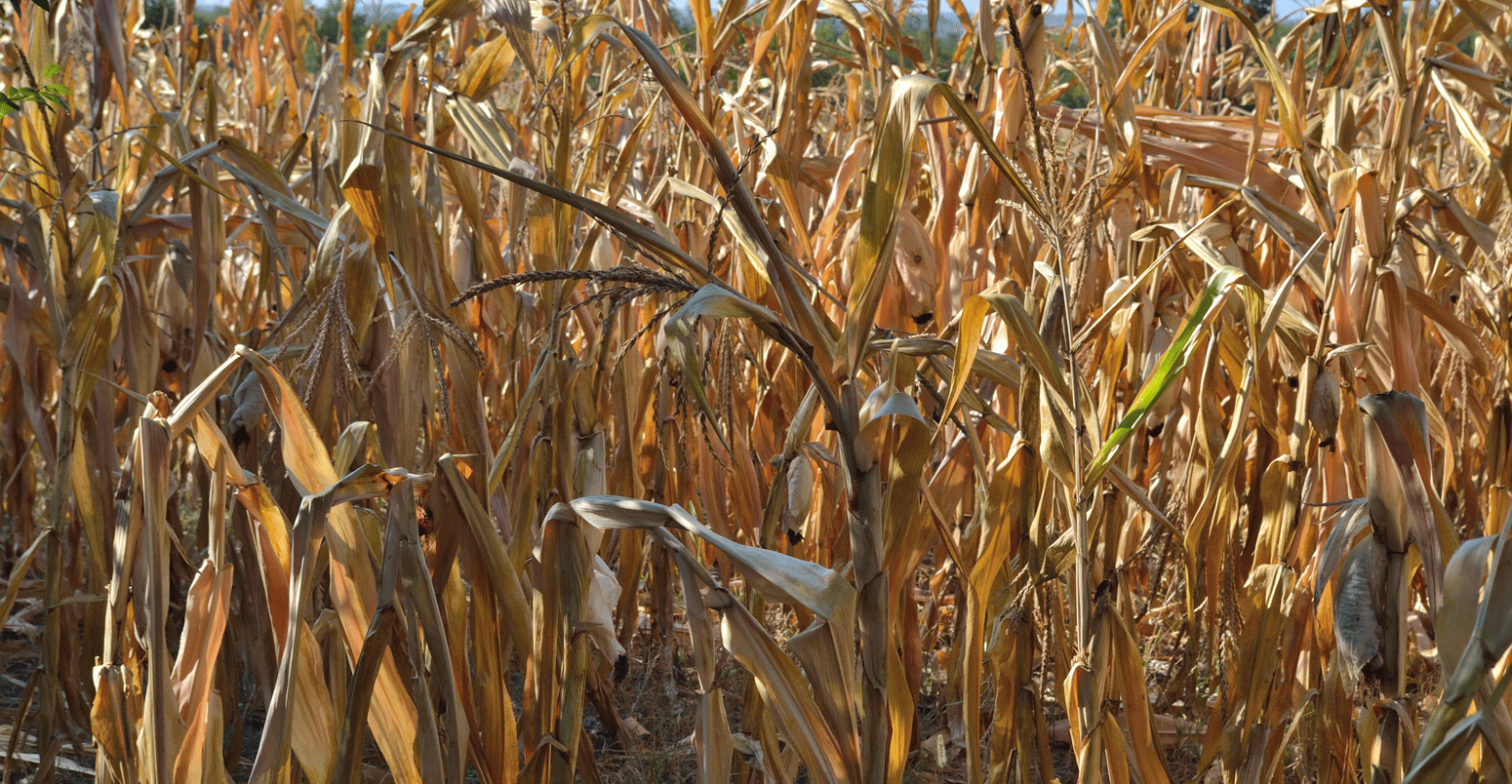
Increasing droughts will drive ‘billions’ in economic losses in Europe
Ayesha Tandon
05.10.21Ayesha Tandon
10.05.2021 | 4:04pmEconomic damages from droughts in the EU and UK could rise by one third by the end of the century, new research finds – even if warming is limited to 1.5C and countries implement adaptation measures.
The study, published in Nature Climate Change, finds that droughts currently drive around €9bn in annual economic losses across the EU and UK – mainly from damage to the agricultural sector. However, the authors warn that, as the climate warms, more frequent and intense droughts are expected across most of Europe – particularly in Meditteranean countries.
If nations adapt to the worsening droughts and warming is limited to 1.5C above pre-industrial levels, annual losses from drought would still rise to almost €12bn, the study finds. However, if countries do not adapt, drought losses could hit €24bn under this warming level.
More extreme warming would bring greater losses, the study warns. For example, 4C would drive €33bn of economic losses if adaptation measures are taken – and €65bn if they are not.
Worsening droughts
In 2018 and 2019, Europe saw two “exceptional” consecutive summer droughts – a combination of events that scientists called “unprecedented in the last 250 years”.
During the 2018 drought, some parts of central Europe received less than half of their usual rainfall, research shows. This drought was driven in part by an extreme heatwave that was made five times more likely by climate change – a fact that was highlighted in much of the media coverage that followed.
Studies show that climate change is already making droughts worse and that, as the climate warms, more severe and frequent droughts are expected. Previous research has already identified the drought risks in European cities.
Dr Gustavo Naumann from the Joint Research Centre (JRC) at the European Commission is the lead author on a new study that aims to calculate the economic loss that would result from future droughts across Europe. He tells Carbon Brief that the impacts of droughts can be wide-ranging:
“Drought is among the most complex and severe climate-related hazards, with wide-ranging and cascading impacts across societies, ecosystems and economies. These impacts can accumulate beyond the areas of the drought, remain well beyond its end, and harm many economic sectors such as agriculture, energy production, inland water transportation, water supply and infrastructure.”
However, droughts are a nuanced climate-related impact. They are broadly defined by a lack of water, but can be measured in a range of ways including precipitation, soil moisture content and groundwater reserves.
This study focuses on changes in the volume of water flowing through rivers, known as “streamflow”. The authors use a combination of regional climate model simulations and hydrological models to classify a river as experiencing “hydrological drought” when its minimum annual streamflow dips below a threshold value.
The maps below show how streamflow in rivers is expected to change across Europe at 1.5C, 2C, 3C and 4C warming above pre-industrial levels. Reds and yellows indicate more frequent droughts in a warmer climate, while blue indicates less frequent droughts.
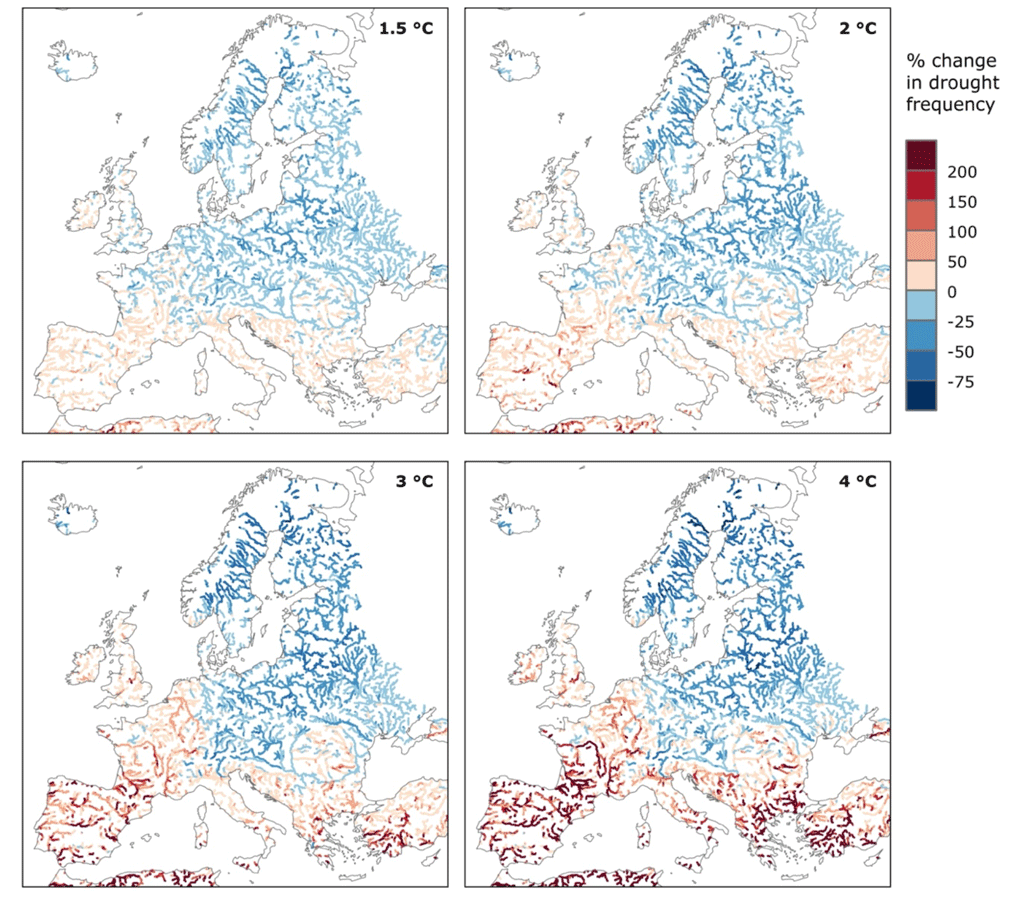
The maps show that, as the climate warms, droughts are expected to become less frequent in northern Europe and more frequent in southern Europe. This is in line with past trends.
The contrast occurs because of regional variations in rainfall change, which is expected to increase in northern Europe and decrease to the south. While evaporation is projected to increase across Europe as temperatures rise, this is outweighed by increased rainfall in the north.
Economic impacts
The researchers combined their analysis with country-level data on economic losses from past droughts during 1990–2016. Using this information, the team determined how much economic damage could be caused by the droughts projected in their models.
The study finds that, in the climate and economy of 1981-2010, droughts were responsible for around €9bn (£7.75bn) of damages per year to the economies of countries in the EU and the UK. However, this value is expected to rise as economies grow and temperatures increase. (Note that European countries that are not in the EU, with the exception of the UK, are not included in this study.)
The authors explore damages due to drought under three scenarios of socioeconomic development. In the “base economy” scenario, the authors assume that socioeconomic conditions remain at 2015 levels – in other words, the only thing that changes are average temperatures.
The authors also investigate two scenarios in which the population and economy continue to grow until 2100. In the “static vulnerability” scenario, the authors assume that countries do not adapt in any way to the increasing threat from droughts as the economy grows, while in the “dynamic vulnerability” scenario, countries continuously adapt to the changing threat of drought.
Naumann notes that these adaptation measures would include advances such as the “development of stress-resistant crops to improve yield stability under water-shortage conditions” and “improved water-use efficiency in power production”.
The expected economic losses from drought for the UK and EU under the different scenarios are shown below. The “baseline” scenario is shown on the left, the “dynamic vulnerability” scenario in the middle, and the “static vulnerability” scenario on the right. Darker colours indicate higher levels of warming.
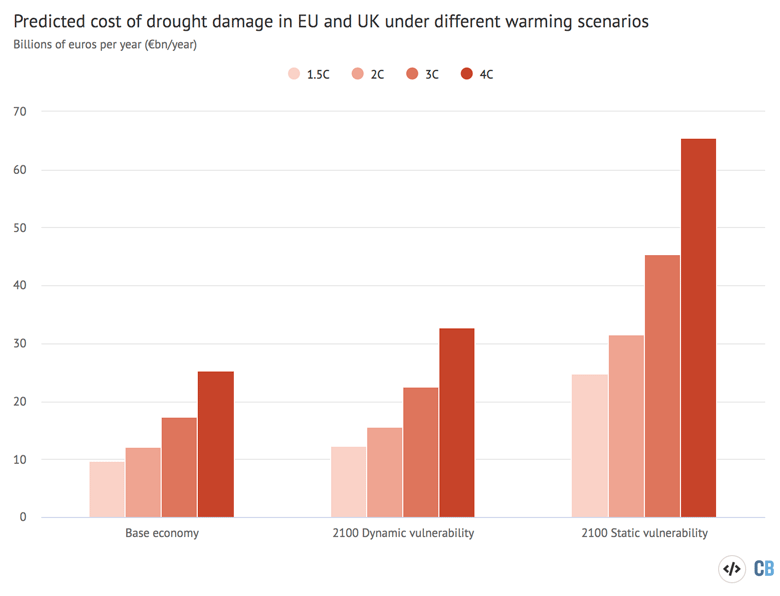
The authors find that, in the baseline scenario that maintains today’s economy, “limiting warming to well below 2C would mostly stabilise overall EU drought losses”. However, a 4C warmer climate would result in drought losses that are nearly three times larger than today.
When comparing the static and dynamic scenarios, the authors find that drought impacts in 2100 could be “roughly halved” – a decrease ranging from 40% for the richest countries in Europe to 60% for the poorest countries in Europe – if adaptation measures are implemented. This would keep damages from drought relative to the size of the economy below present-day levels, “even with high levels of warming”.
Naumann also adds that there is a clear “negative relation” between wealth and drought vulnerability, meaning that the poorest countries are likely to see the greatest impacts from drought.
Agriculture and energy
As well as projecting economic losses for Europe as a whole, the study also analyses individual regions and countries. It notes, for example, that Spain currently has the highest drought loss at €1.5bn per year for the baseline period, closely followed by other Mediterranean countries such as Italy and France. Meanwhile, countries in mid and northern Europe – such as the UK, Finland and Sweden – are typically hit the least hard.
The study finds that climate change is likely to exacerbate these trends. The authors group European countries into four regions – Atlantic, boreal, Mediterranean and continental – as shown on the map below. The bar charts show the drought changes projected for each region at different warming levels, with the bars showing how much of each region is likely to see an increase (red) or decrease (blue) in drought frequency.
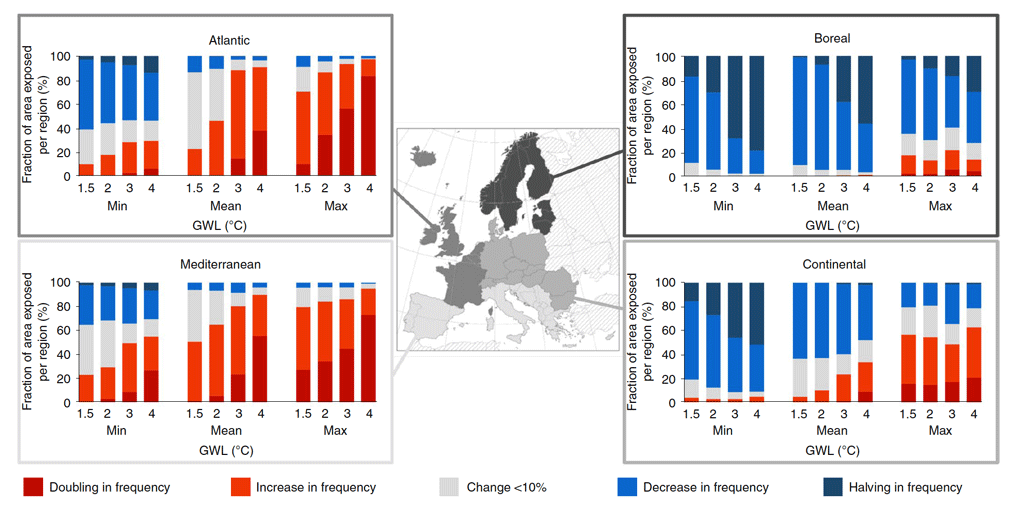
The authors then break down the economic losses from drought into five sectors. The chart below shows how economic loss is split between different sectors and regions in today’s economy (top line) and in 2100 (bottom line) assuming static vulnerability and an average of the future warming scenarios. From darkest to lightest blue, the five sectors are agriculture, energy, water, transport and buildings.
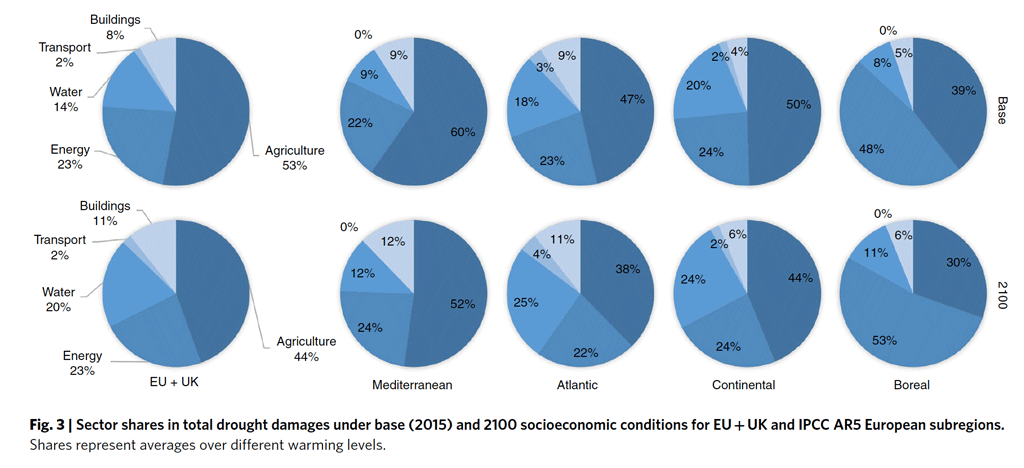
The study finds agriculture currently accounts for over half of all economic losses from drought. Dr Giovanni Forzieri, who was not involved in the study, but is also at the JRC, tells Carbon Brief why droughts are expected to impact agriculture in particular:
“Droughts can trigger a range of adverse impacts on agriculture, such as a reduction of quantity and quality of water resources and irrigation water and an increase in heat stress beyond the plant thermal tolerance, ultimately leading to potential widespread crop failures. A recent study has shown that droughts have reduced crop production by 9–10% at the global level over the last five decades leading to 3bntonnes of lost harvest – about three years of global maize harvest.”
Agriculture will continue to be the most significantly impacted in almost all of the regions studied in the future, the authors note. However, they add that agriculture is likely to become “less economically prevalent” in the future, and so the share of total damages from agriculture is likely to drop in the future.
Naumann tells Carbon Brief that drought can also affect power generation, because this often depends on water availability – either directly in the case of hydropower, or indirectly thanks to cooling systems for power generators. In boreal regions, where hydropower is a particularly important source of energy, this impact is particularly noticeable, according to the study.
Dr Justin Mankin, an assistant professor at Dartmouth College, tells Carbon Brief that the “very ambitious” study is “interesting but incredibly uncertain”, as it is “unclear what fraction of the uncertainty in the results is attributable to climate, hydrologic or economic assumptions”. He adds :
“What’s challenging here is that the damages of drought are presented as “level effects” on the economy (which they may well be), meaning that the droughts do not affect a sector or region’s trajectory of economic growth, but only the economic production for the year of the drought.”
While this assumption “may not be problematic”, Mankin says, it has implications for the projected impacts of drought because “the increasing frequency and magnitude of droughts are not considered as factors that shape socioeconomic trajectories of growth”. However, he says that he is “heartened by the authors’ effort to consider the myriad factors that make drought impactful”.
Naumann, G. et al (2021) Increased economic drought impacts in Europe with anthropogenic warming, Nature Climate Change, doi:10.1038/s41558-021-01044-3

